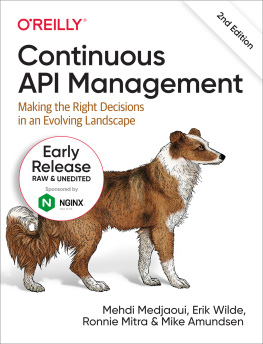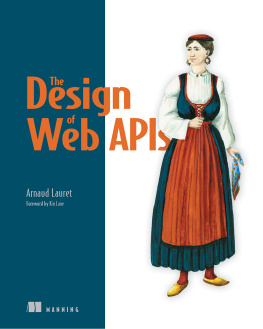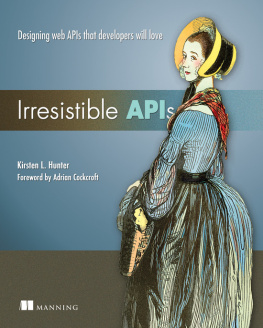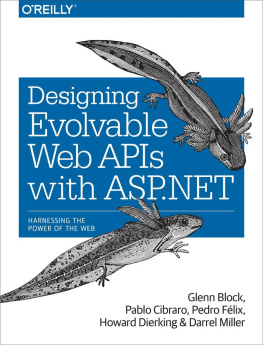ePUB is an open, industry-standard format for eBooks. However, support of ePUB and its many features varies across reading devices and applications. Use your device or app settings to customize the presentation to your liking. Settings that you can customize often include font, font size, single or double column, landscape or portrait mode, and figures that you can click or tap to enlarge. For additional information about the settings and features on your reading device or app, visit the device manufacturers Web site.
Many titles include programming code or configuration examples. To optimize the presentation of these elements, view the eBook in single-column, landscape mode and adjust the font size to the smallest setting. In addition to presenting code and configurations in the reflowable text format, we have included images of the code that mimic the presentation found in the print book; therefore, where the reflowable format may compromise the presentation of the code listing, you will see a Click here to view code image link. Click the link to view the print-fidelity code image. To return to the previous page viewed, click the Back button on your device or app.
Praise for Principles of Web API Design
Ive had the good fortune to work alongside and learn from James over the past several years. His varied institutional knowledge, along with his depth of experience and eye for practical application, makes him unique among his peers. I am ecstatic that others now have the opportunity, in this book, to benefit from Jamess compelling, pragmatic vision for how to make better APIs. Principles of Web API Design surveys the gamut of available techniques and sets forth a prescriptive, easy-to-follow approach. Teams that apply the guidance in this book will create APIs that better resonate with customers, deliver more business value in less time, and require fewer breaking changes. I cannot recommend Principles of Web API Design enough.
Matthew Reinbold, Director of API Ecosystems, Postman
James is one of the preeminent experts on API design in the industry, and this comprehensive guide reflects that. Putting API design in the context of business outcomes and digital capabilities makes this a vital guide for any organization undergoing digital transformation.
Matt McLarty, Global Leader of API Strategy at MuleSoft, a Salesforce company
In modern software development, APIs end up being both the cause of and solution to many of the problems we face. Jamess process for dissecting, analyzing, and designing APIs from concepts to caching creates a repeatable approach for teams to solve more problems than they create.
D. Keith Casey, Jr., API Problem Solver, CaseySoftware, LLC
Following Jamess clear and easy-to-follow guide, in one afternoon I was able to apply his process to current real-world use cases. I now have the practical guidance, techniques, and clear examples to help me take those next vital steps. Recommended reading for anyone connected to and working with APIs.
Joyce Stack, Architect, Elsevier
Principles of Web API Design uncovers more than principles. In it, youll learn a processa method to design APIs.
Arnaud Lauret, API Handyman
This insightful playbook guides API teams through a structured process that fosters productive collaboration, valuable capability identification, and best-practice contract crafting. James distills years of experience into a pragmatic roadmap for defining and refining API products, and also provides a primer for API security, eventing, resiliency, and microservices alignment. A must-read for architects either new to the API discipline or responsible for onboarding new teams and instituting a structured API definition process.
Chris Haddad, Chief Architect, Karux LLC
Principles of Web API Design

Principles of Web API Design
Delivering Value with APIs and Microservices
James Higginbotham

Boston Columbus New York San Francisco Amsterdam Cape Town
Dubai London Madrid Milan Munich Paris Montreal Toronto Delhi Mexico City
So Paulo Sydney Hong Kong Seoul Singapore Taipei Tokyo
Cover image: Anna Om/Shutterstock
: 2021 SmartBear Software
, icons: dependency by Knut M. Synstad from the Noun Project; plug by Vectors Market from the Noun Project; database by MRK from the Noun Project; filter by Landan Lloyd from the Noun Project; command line by Focus from the Noun Project; algorithm by Trevor Dsouza from the Noun Project; name tag by Cindy Clegane from the Noun Project; task list by Royal@design from the Noun Project; quality by Flatart from the Noun Project; broadcast by Yoyon Pujiyono from the Noun Project.
Many of the designations used by manufacturers and sellers to distinguish their products are claimed as trademarks. Where those designations appear in this book, and the publisher was aware of a trademark claim, the designations have been printed with initial capital letters or in all capitals.
The author and publisher have taken care in the preparation of this book, but make no expressed or implied warranty of any kind and assume no responsibility for errors or omissions. No liability is assumed for incidental or consequential damages in connection with or arising out of the use of the information or programs contained herein.
For information about buying this title in bulk quantities, or for special sales opportunities (which may include electronic versions; custom cover designs; and content particular to your business, training goals, marketing focus, or branding interests), please contact our corporate sales department at or (800) 382-3419.
For government sales inquiries, please contact .
For questions about sales outside the U.S., please contact .
Visit us on the Web: informit.com/aw
Library of Congress Control Number: 2021947541
Copyright 2022 Pearson Education, Inc.
All rights reserved. This publication is protected by copyright, and permission must be obtained from the publisher prior to any prohibited reproduction, storage in a retrieval system, or transmission in any form or by any means, electronic, mechanical, photocopying, recording, or likewise. For information regarding permissions, request forms and the appropriate contacts within the Pearson Education Global Rights & Permissions Department, please visit www.pearson.com/permissions.
ISBN-13: 978-0-13-735563-1
ISBN-10: 0-13-735563-7
ScoutAutomatedPrintCode
Pearsons Commitment to Diversity, Equity, and Inclusion
Pearson is dedicated to creating bias-free content that reflects the diversity of all learners. We embrace the many dimensions of diversity, including but not limited to race, ethnicity, gender, socioeconomic status, ability, age, sexual orientation, and religious or political beliefs.
Education is a powerful force for equity and change in our world. It has the potential to deliver opportunities that improve lives and enable economic mobility. As we work with authors to create content for every product and service, we acknowledge our responsibility to demonstrate inclusivity and incorporate diverse scholarship so that everyone can achieve their potential through learning. As the worlds leading learning company, we have a duty to help drive change and live up to our purpose to help more people create a better life for themselves and to create a better world.














